Swifts are present in the country for a shorter time than any other bird. The "10 year average" arrival date is 24th April and they have usually gone by early September.
The bulk of the population breeds in suburban areas, usually in older buildings. The nest is usually inside a cavity in the roof space or walls of buildings.
Displaying birds fly rapidly over the roof of the building containing the nest, whilst calling loudly. These are called screaming parties. In bad weather the parents may abandon the nest site to search for food and the chicks have the ability to go torpid to reduce their energy requirements and retard their development.
In 1995/6 a survey, organised by CAWOS, was held covering all of Cheshire.
The results for the SECOS area were:
| Area | No of birds | No of colonies |
| Shavington | 25 | 1 |
| Willaston | 16 | 1 |
| Wistaston | 30 | 1 |
| Crewe - South | 208 | 10 |
| Crewe - North East | 55 | 4 |
| Crewe - North West | 537 | 6* |
| Haslington | 121 | 2 |
| Alsager | 34 | 5 |
| Sandbach | Not counted | |
| Holmes Chapel | 15 | ? |
| Middlewich | 81 | ? |
| Congleton | 248 | ? |
* including the largest in Cheshire with 450 birds.
and in 2001 SECOS conducted a survey within its own recording area. The results of 2001 survey can be viewed here.

2019 Survey
The aim of the 2019 Survey was to find the location of all breeding colonies and the total number of summering Swifts in the SECOS area. To use this data to compare with the 1995/6 and 2001 surveys.
By visiting potentially suitable nesting habitats (older houses and buildings) and listening for screaming parties, which can often be heard over 400 yards away, and looking for circling Swifts we aimed to count the number of birds flying round and screaming low over the breeding site. Then recording all required known details on the survey form.
Timing is very important for an accurate count to be obtained. The best time is the first week in June. However it is more important that the weather conditions are right and it is essential to only count when it is warm and dry with no, or very light, wind. If conditions are not right in the first week in June, please wait until they are before making your count. It is also essential to get the time of day right. Birds tend to gather round the nesting colony from mid-evening but peak numbers are usually obtained after 8:30pm. Beyond 10:00pm the birds tend to drift away for the night. So please count between 9:00 and 10:00 p.m.
It was not intended to specify a search area for everybody involved. However, we have members located throughout the SECOS area so if everybody took a recording form and just looked around their locality we should cover the whole of the SECOS Recording Area.
The summary of results for the 2019 survey can be downloaded here
If you need advice or information please contact John Thompson
Swifts in 2023
Swifts in this area were surveyed in 1995 as part of a national survey by the BTO. The results are available to view on the SECOS website. A further survey was carried out locally in 2001 and the results of that are also available on the SECOS website.
John and I had hoped to put some effort into monitoring Swifts again this summer but for various reasons we could not do as detailed a study as we had planned. However, with some help from Glyn we have managed to monitor a few sites. Sadly the results have proved what we already knew – that Swift numbers have declined significantly and they are now quite scarce as a breeding bird.
The main site in the West End of Crewe gave a maximum count of 450 birds in 1995. This made it one of the largest breeding colonies in the UK. In the repeat survey in 2001 the number was down to 120 and this year we could only count around 50 birds.
The other two sites where results could be compared were Haslington with 90 in 1995, 35 in 2001 and 6 this year and Wheelock Heath with 31 in 1995, 7 in 2001 and 0 now.
Swifts are difficult to monitor and reasons for the decline are not sure but are considered to include loss of insect food, poor summer weather and loss of nest sites. Swift was included in the green list of ‘Conservation Concern’ but moved to the amber list in 2009 and the red list in 2021.
Colin Lythgoe
